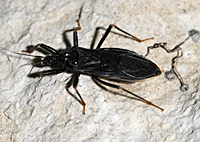[All pictures of garden wildlife on this page are thumbnails. Click on any thumbnail for a large format to be displayed.]
Mask Hunter (Reduvius personatus)
The masked hunter (Reduvius personatus) a member of the assassin bug family (Reduviidae) and of the subfamily Reduviinae. Its English and Latin names refer to the insect's behaviour at the nymphal stage when it covers the body with dust as a camouflage.
They are dark brown to black in colour and about 17-22mm in lenth with elongated oval shape of the body. Both nymphs and adults have a similarily shaped and coloured bodies. The nymphs however often appear light-coloured on the surface as part of their camouflage but underneath that light dusty layer they are as dark as the adults. The nyphs are smaller and their wings are not fully developed. The eggs are being laid in the middle of summer and the nymphs overwinter. They come originally from Europe but they have become common in some parts of USA as well.
Reduvius personatus hunts for small arthropods, including woodlice, lacewings, earwigs, and bedbugs. This makes it a somewhat welcome guest in your living surroundings. The body camouflage is used as a hunting technique making it easier to apprach the victims unnoticed and then suddenly attacked and caught with the predator's forelegs. The mask hunters pierce the bodies of the victims with sucking mouthparts.
They are not really dangerous for humans as they do not feed on human blood. However, if they feel threatened or disturbed they can bite in self-defence. The bite can be painful and causing numbness and swelling but - contrary to bites of other instects - they form no risk of transfering any diseases to humans.

© Copyright 1998-2024 gardensafari.net (Hania Berdys)

 English / engels
English / engels  Dutch / nederlands
Dutch / nederlands
